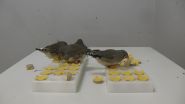(Press-News.org) Researchers from Scripps Institution of Oceanography at UC San Diego have accurately mapped out the movement of the devastating 7.8-magnitude Nepal earthquake that killed over 9,000 and injured over 23,000 people. Scientists have determined that the earthquake was a rupture consisting of three different stages. The study could help a rapidly growing region understand its future seismic risks.
The Himalayan region is particularly prone to earthquakes and this study will serve as an important benchmark for understanding where future earthquakes may occur, especially since the area has experienced high population growth over the past few decades.
The study assessed the presence of low frequency and high frequency waves over the three stages of the earthquake. High frequency waves cause more shaking, thereby posing the greatest risks for structural damages. Low frequency waves are less violent and less damaging to buildings and infrastructure.
"The Nepal earthquake is a warning sign that the region is of high seismic risk, and each earthquake behaves differently. Some earthquakes jump from one fault line to another, whereas the Nepal quake apparently occurred on the same fault line in three different stages, moving eastward," said Scripps geophysicist Peter Shearer, "Using this research, we can better understand and identify areas of high seismic hazard in the region."
This first peer-reviewed study on the April 2015 earthquake in Nepal, "Detailed rupture imaging of the 25 April 2015 Nepal earthquake using teleseismic P waves" was published online July 16 in the American Geophysical Union (AGU) journal Geophysical Research Letters.
Using the Global Seismic Network (GSN), Shearer and Scripps graduate student Wenyuan Fan were able to unravel the complex evolution of fault slips during this earthquake. The study concludes that the rupture traveled mostly eastward and occurred in three distinct stages; Stage 1 was weak and slow; Stage 2 was near Kathmandu and had the greatest slip but was relatively deficient in high-frequency radiation; and Stage 3 was relatively slow as well. Overall, this earthquake was more complicated, with multi-stage movements on multiple faults, than smooth models of continuous rupture on a single fault plane.
"Using the GSN instead of regional array data really enhanced the spatial resolution of the back-projection images and helped us see that frequency-dependent rupture was one of the main features of this earthquake," said Fan. "Stage 2 was high-frequency-deficient and occurred closest to Kathmandu, which was probably why ground shaking was less severer than expected for such a high-magnitude earthquake."
The Global Seismic Network provides high-quality broadband digital seismic data for monitoring earthquakes and learning about Earth structure. A precursor to this network was initiated by Scripps researchers in the 1960s and is still in use today. Scripps currently operates one-third of the 153 global seismometers of the GSN. Fan and Shearer used the GSN data because they are open-source (available to anyone), have good coverage of the Nepal region, and have a long history of reliable recordings.
"In general, understanding large earthquakes will inform our ability to forecast the nature of future earthquakes," said Shearer.
Shearer and Fan hope to use the same methodology to study other large, global earthquakes from the past decade to provide a broader picture of earthquake behavior and help in predicting ground shaking for future events.
INFORMATION:
The study was funded by the National Science Foundation (Grant EAR -111111).
SEDE BOQER, Israel...July 23, 2015 - Ben-Gurion University of the Negev (BGU) and University of Western Australia researchers have developed a new process to develop few-layer graphene for use in energy storage and other material applications that is faster, potentially scalable and surmounts some of the current graphene production limitations.
Graphene is a thin atomic layer of graphite (used in pencils) with numerous properties that could be valuable in a variety of applications, including medicine, electronics and energy. Discovered only 11 years ago, graphene is one ...
The physical symptoms of weakness and fatigue from multiple sclerosis (MS) can rock a person's confidence and ability to engage in what he or she feels is important, from being a good parent and friend to taking up a hobby, according to Matthew Plow, assistant professor from Case Western Reserve University's Frances Payne Bolton School of Nursing.
To help people with MS maintain autonomy and independence, a team of researchers set out to determine what factors prevented individuals from undertaking and enjoying the activities they believe are most important to live fulfilling ...
Researchers at the University of Birmingham have made a breakthrough in understanding how mutated genes in leukaemia reprogram blood stem cells and send them spiralling out of control.
The findings help to explain the early development of leukaemia, representing the essential first step to developing new treatments for patients based on these findings.
A study, published in Cell Reports by Professors Peter Cockerill and Constanze Bonifer, investigated the role of one specific mutation in the FLT3 gene found in acute myeloid leukaemia (AML).
AML is diagnosed in ...
Researchers add a new twist to the more than century old biological principles of Mendelian inheritance - describing a small group of cells in pregnant mothers that promote genetic fitness and multi-generational reproductive health.
Scientists at Cincinnati Children's Hospital Medical Center report their findings online July 23 in Cell. The study suggests a scientific basis for developing new therapies to promote reproductive health and prevent pregnancy complications like prematurity and stillbirth, according to Sing Sing Way, MD, PhD, senior author and pediatrician ...
When does aging really begin? Two Northwestern University scientists now have a molecular clue. In a study of the transparent roundworm C. elegans, they found that adult cells abruptly begin their downhill slide when an animal reaches reproductive maturity.
A genetic switch starts the aging process by turning off cell stress responses that protect the cell by keeping important proteins folded and functional. The switch is thrown by germline stem cells in early adulthood, after the animal starts to reproduce, ensuring its line will live on.
While the studies were conducted ...
Highly-social zebra finches learn foraging skills from their parents. However, new research has found that when juvenile finches are exposed to elevated stress hormones just after hatching, they will later switch strategies and learn only from unrelated adult birds - ignoring their parents' way of doing things and instead gaining foraging skills from the wider network of other adult finches.
Researchers say that spikes in stress during early development may act as a cue that their parents are doing something wrong, triggering the young birds to switch their social learning ...
If you find yourself downing that extra piece of chocolate fudge cake even though you're not hungry, it might be the absence of a hormone in your brain that's causing you to overeat purely for pleasure.
In a new Rutgers Robert Wood Johnson Medical School study published in Cell Reports, researchers found that when the hormone glucagon like peptide-1 (GLP-1) was reduced in the central nervous system of laboratory mice, they overate and consumed more high fat food.
"The mice in which the GLP-1 deficiency was induced ate beyond the need for calories and showed an increase ...
A new study by researchers at University of California, San Diego School of Medicine reveals a protein's critical - and previously unknown -- role in the development and progression of acute myeloid leukemia (AML), a fast-growing and extremely difficult-to-treat blood cancer.
The finding offers a novel target for better treating AML, and possibly other cancers, by cutting off the ability of tumors to access nearby cellular players that feed its growth. The study was published July 23 in Cell Stem Cell.
"The work really focuses on trying to understand the dependence ...
Alexandria, VA - EARTH Magazine takes you to Le Mans, France, to cover how the World Endurance Competition (WEC) race series is transforming automotive efficiency in both high-performance racing and the commercial automotive industries. EARTH's latest feature explores the science behind efficiency upgrades used by three major racing competitors: Porsche, Audi and Toyota.
Using physics and cutting-edge materials results in a "fascinating case study of how unbridled competition can produce unique, innovative and extraordinary solutions to engineering barriers once thought ...
CHAPEL HILL, NC (July 23, 2015) - For years, a crisis has been brewing in molecular biology. The problem is that antibodies--research tools used to identify key proteins at work in a cell--aren't always what they seem. Unreliable antibodies have led to numerous instances of false findings, failed experiments, and wasted money and samples.
Enter the Histone Antibody Specificity Database, a newly launched online portal that lets scientists find the right antibodies for their research with a much higher degree of confidence than ever before. Rather than relying on the claims ...

